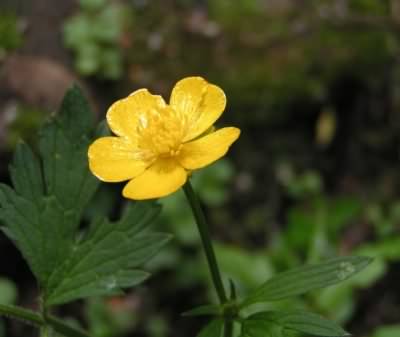
Photo ©2004 Sannse
Click photo for a larger image

Creeping Buttercup - Ranunculus repens
Family - Ranunculaceae
Also known as - Creeping Crowfoot

Photo ©2004 Sannse
Click photo for a larger image
This plant is poisonous
Native to Europe, Asia and northwestern Africa but an introduced invasive in America, Creeping Buttercup is a herbaceous, stoloniferous perennial plant growing to 50cm tall in lawns, gardens, moist disturbed meadows, ditches, and areas along roadsides. It has both prostrate running stems, which produce roots and new plants at the nodes, and more or less erect flowering stems, with both the stems and the leaves being finely hairy. The basal leaves are divided into three broad leaflets 1.5–8cm (0.6–3.2in) long, shallowly to deeply lobed, borne on a 4–20cm (1.6–8in) long petiole.
Bright golden yellow flowers, 2–3cm (0.8–1.2in) diameter, usually with five petals are seen from May to August. The flowers are insect pollinated ripening to a cluster of achenes 2.5–4mm (0.1–0.15in) long. There is a double form of Creeping Buttercup that has 10–20 petals per flower, rather than the usual five, which has also escaped into the wild but is less common. Creeping Buttercup can be distinguished from other Ranunculus spp. by the presence of its stolons and the pale white blotches on the leaves.
BCP do not advise or recommend that Creeping Buttercup – Ranunculus repens is eaten or used as an herbal remedy. It is a poisonous plant containing the glycoside ranunculin, which can cause inflammation and blistering of the skin.
Site design ©1999– Brickfields Country Park - Privacy -